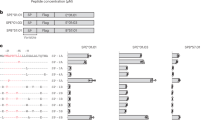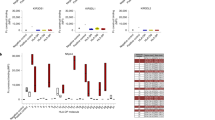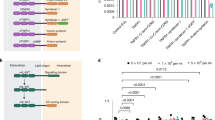Abstract
Enterovirus 71 (EV71) is a major causative agent of hand, foot and mouth disease (HFMD), a common febrile disease occurring mainly in young children. Although clinical manifestations of HFMD are usually mild and self limiting, a severe EV71 outbreak can lead to a diverse array of neurological diseases. Identification of the specific cellular receptors is crucial for elucidating the mechanism of early virus-host interactions and the pathogenesis of enteroviruses1. Here we identify human P-selectin glycoprotein ligand-1 (PSGL-1; CD162), a sialomucin membrane protein expressed on leukocytes that has a major role in early stages of inflammation2,3,4, as a functional receptor for EV71 using an expression cloning method by panning5. The N-terminal region of PSGL-1 binds specifically to EV71. Stable PSGL-1 expression allowed EV71 entry and replication, and development of cytopathic effects in nonsusceptible mouse L929 cells. Five out of eight EV71 strains bound soluble PSGL-1 and used intact PSGL-1 as the primary receptor for infection of Jurkat T cells. Three other EV71 strains did not use PSGL-1, suggesting the presence of strain-specific replication of EV71 in leukocytes. EV71 replicated in nonleukocyte cell lines in a PSGL-1–independent manner, indicating the presence of alternative receptor(s) for EV71. The identification of PSGL-1 as a receptor for EV71 sheds new light on a role for PSGL-1–positive leukocytes in cell tropism and pathogenesis during the course of HFMD and other EV71-mediated diseases.
This is a preview of subscription content, access via your institution
Access options
Subscribe to this journal
Receive 12 print issues and online access
$209.00 per year
only $17.42 per issue
Buy this article
- Purchase on Springer Link
- Instant access to full article PDF
Prices may be subject to local taxes which are calculated during checkout




Similar content being viewed by others
References
Rossmann, M.G., He, Y. & Kuhn, R.J. Picornavirus-receptor interactions. Trends Microbiol. 10, 324–331 (2002).
Laszik, Z. et al. P-selectin glycoprotein ligand-1 is broadly expressed in cells of myeloid, lymphoid, and dendritic lineage and in some nonhematopoietic cells. Blood 88, 3010–3021 (1996).
Sako, D. et al. Expression cloning of a functional glycoprotein ligand for P-selectin. Cell 75, 1179–1186 (1993).
Somers, W.S., Tang, J., Shaw, G.D. & Camphausen, R.T. Insights into the molecular basis of leukocyte tethering and rolling revealed by structures of P- and E-selectin bound to SLeX and PSGL-1. Cell 103, 467–479 (2000).
Shimojima, M. et al. Usage of myeloma and panning in retrovirus-mediated expression cloning. Anal. Biochem. 315, 138–140 (2003).
Oberste, M.S., Maher, K., Kilpatrick, D.R. & Pallansch, M.A. Molecular evolution of the human enteroviruses: correlation of serotype with VP1 sequence and application to picornavirus classification. J. Virol. 73, 1941–1948 (1999).
Chan, L.G. et al. Deaths of children during an outbreak of hand, foot and mouth disease in Sarawak, Malaysia: clinical and pathological characteristics of the disease. Clin. Infect. Dis. 31, 678–683 (2000).
Ho, M. et al. An epidemic of enterovirus 71 infection in Taiwan. N. Engl. J. Med. 341, 929–935 (1999).
McMinn, P.C. An overview of the evolution of enterovirus 71 and its clinical and public health significance. FEMS Microbiol. Rev. 26, 91–107 (2002).
Lin, T.Y., Hsia, S.H., Huang, Y.C., Wu, C.T. & Chang, L.Y. Proinflammatory cytokine reactions in enterovirus 71 infections of the central nervous system. Clin. Infect. Dis. 36, 269–274 (2003).
Wang, S.M. et al. Pathogenesis of enterovirus 71 brainstem encephalitis in pediatric patients: roles of cytokines and cellular immune activation in patients with pulmonary edema. J. Infect. Dis. 188, 564–570 (2003).
Chen, L.C. et al. Enterovirus 71 infection induces Fas ligand expression and apoptosis of Jurkat cells. J. Med. Virol. 78, 780–786 (2006).
Snapp, K.R. et al. A novel P-selectin glycoprotein ligand-1 monoclonal antibody recognizes an epitope within the tyrosine sulfate motif of human PSGL-1 and blocks recognition of both P- and L-selectin. Blood 91, 154–164 (1998).
Thatte, A. et al. Binding of function-blocking mAbs to mouse and human P-selectin glycoprotein ligand-1 peptides with and without tyrosine sulfation. J. Leukoc. Biol. 72, 470–477 (2002).
Li, F. et al. Visualization of P-selectin glycoprotein ligand-1 as a highly extended molecule and mapping of protein epitopes for monoclonal antibodies. J. Biol. Chem. 271, 6342–6348 (1996).
Brown, B.A., Oberste, M.S., Alexander, J.P. Jr., Kennett, M.L. & Pallansch, M.A. Molecular epidemiology and evolution of enterovirus 71 strains isolated from 1970 to 1998. J. Virol. 73, 9969–9975 (1999).
Arita, M., Ami, Y., Wakita, T. & Shimizu, H. Cooperative effect of the attenuation determinants derived from poliovirus Sabin 1 strain is essential for attenuation of enterovirus 71 in the NOD/SCID mouse infection model. J. Virol. 82, 1787–1797 (2008).
Chua, B.H., Phuektes, P., Sanders, S.A., Nicholls, P.K. & McMinn, P.C. The molecular basis of mouse adaptation by human enterovirus 71. J. Gen. Virol. 89, 1622–1632 (2008).
Kung, C.M. et al. Differences in replication capacity between enterovirus 71 isolates obtained from patients with encephalitis and those obtained from patients with herpangina in Taiwan. J. Med. Virol. 79, 60–68 (2007).
Kuo, R.L., Kung, S.H., Hsu, Y.Y. & Liu, W.T. Infection with enterovirus 71 or expression of its 2A protease induces apoptotic cell death. J. Gen. Virol. 83, 1367–1376 (2002).
Hsueh, C. et al. Acute encephalomyelitis during an outbreak of enterovirus type 71 infection in Taiwan: report of an autopsy case with pathologic, immunofluorescence and molecular studies. Mod. Pathol. 13, 1200–1205 (2000).
Wong, K.T. et al. The distribution of inflammation and virus in human enterovirus 71 encephalomyelitis suggests possible viral spread by neural pathways. J. Neuropathol. Exp. Neurol. 67, 162–169 (2008).
Nagata, N. et al. Pyramidal and extrapyramidal involvement in experimental infection of cynomolgus monkeys with enterovirus 71. J. Med. Virol. 67, 207–216 (2002).
Nagata, N. et al. Differential localization of neurons susceptible to enterovirus 71 and poliovirus type 1 in the central nervous system of cynomolgus monkeys after intravenous inoculation. J. Gen. Virol. 85, 2981–2989 (2004).
Ong, K.C. et al. Pathologic characterization of a murine model of human enterovirus 71 encephalomyelitis. J. Neuropathol. Exp. Neurol. 67, 532–542 (2008).
Chang, S.C., Lin, J.Y., Lo, L.Y.C., Li, M.L. & Shih, S.R. Diverse apoptotic pathways in enterovirus 71–infected cells. J. Neurovirol. 10, 338–349 (2004).
Chen, C.S. et al. Retrograde axonal transport: a major transmission route of enterovirus 71 in mice. J. Virol. 81, 8996–9003 (2007).
World Health Organization. Outbreak news. Enterovirus, China. Wkly. Epidemiol. Rec. 83, 169–170 (2008).
Kitamura, T. & Morikawa, Y. Isolation of T-cell antigens by retrovirus-mediated expression cloning. Methods Mol. Biol. 134, 143–152 (2000).
Acknowledgements
We thank N. Takeda, S. Morikawa, Y. Matsuura, K. Moriishi, S. Koike, S. Yamayoshi and Y. Izumiya for helpful discussions; Y. Ami for technical advice regarding FACS; and N. Nishimura for preparing figures. We also thank M. Sinniah, M. Yusof (Institute for Medical Research, Malaysia) for providing EV71-SK-EV006 and KED005, N. Onnimala, Y. Pongsuwanna (National Institute of Health, Thailand) for providing EV71-02363, Y. Okuno (Osaka Prefectural Institute of Public Health) for providing EV71-C7/Osaka, K. Mizuta (Yamagata Prefectural Institute of Public Health) for providing EV71-75-Yamagata, A. Makino, Y. Tohya, H. Akashi (University of Tokyo) for providing P3U1 cells, H. Sakata (National Institute of Infectious Diseases, Japan) for providing L929 cells, and H. Shirato (National Institute of Infectious Diseases, Japan) for providing MOLT-4 and MT-2 cells. We are grateful to J. Wada for technical assistance. This work was supported by a Grant-in-Aid for Young Scientists from the Ministry of Education, Culture, Sports, Science and Technology, Japan (Y.N.). Y.N. and H.S. were supported in part by a Grant-in-Aid for Research on Emerging and Re-emerging Infectious Diseases and a Grant-in-Aid for the Promotion of Polio Eradication, from the Ministry of Health, Labour and Welfare, Japan.
Author information
Authors and Affiliations
Contributions
Y.N. designed and performed experiments, analyzed data and wrote the paper; M.S. improved the expression cloning method; Y.T. prepared and characterized EV71-specific mAbs; and T.M. and T.W. analyzed data and wrote the paper. H.S. planned the project, designed experiments, analyzed data and wrote the paper. All authors discussed the results and commented on the manuscript.
Corresponding author
Supplementary information
Supplementary Text and Figures
Supplementary Figs. 1–4, Supplementary Tables 1–4 and Supplementary Methods (PDF 1529 kb)
Rights and permissions
About this article
Cite this article
Nishimura, Y., Shimojima, M., Tano, Y. et al. Human P-selectin glycoprotein ligand-1 is a functional receptor for enterovirus 71. Nat Med 15, 794–797 (2009). https://doi.org/10.1038/nm.1961
Received:
Accepted:
Published:
Issue Date:
DOI: https://doi.org/10.1038/nm.1961
This article is cited by
-
Current status of hand-foot-and-mouth disease
Journal of Biomedical Science (2023)
-
Insights into enterovirus a-71 antiviral development: from natural sources to synthetic nanoparticles
Archives of Microbiology (2023)
-
Research progress on pathogenic and therapeutic mechanisms of Enterovirus A71
Archives of Virology (2023)
-
Recent advances in enterovirus A71 pathogenesis: a focus on fatal human enterovirus A71 infection
Archives of Virology (2022)
-
Structural and functional analysis of a potent human neutralizing antibody against enterovirus A71
Science China Life Sciences (2022)



